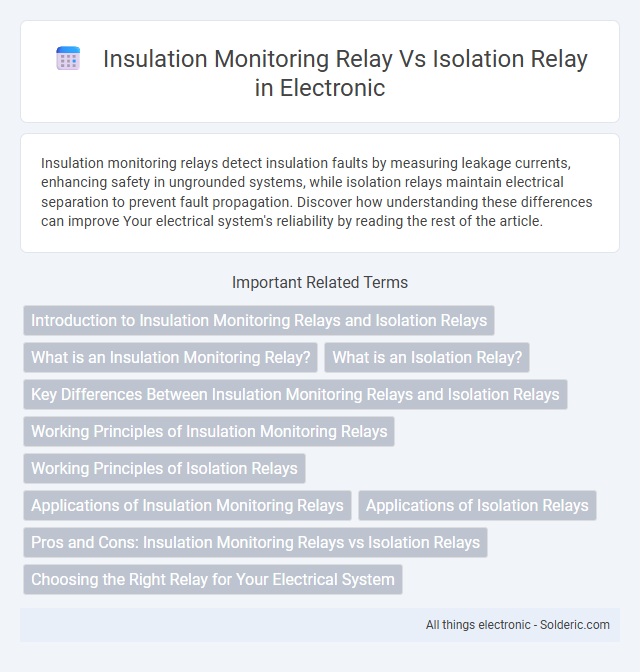Insulation monitoring relays detect insulation faults by measuring leakage currents, enhancing safety in ungrounded systems, while isolation relays maintain electrical separation to prevent fault propagation. Discover how understanding these differences can improve Your electrical system's reliability by reading the rest of the article.
Comparison Table
| Feature | Insulation Monitoring Relay | Isolation Relay |
|---|---|---|
| Purpose | Detects insulation faults in electrical systems | Controls electrical isolation between circuits |
| Function | Monitors insulation resistance to ground | Enables or disables circuit isolation based on control signals |
| Application | Used in IT systems, medical equipment for safety | Used in switching, protection, and automation systems |
| Signal Type | Continuous resistance monitoring | Switching of electrical isolation |
| Output | Alarm or trip signal on insulation fault | Relay contact switching |
| Safety Role | Prevents electric shock and equipment failure | Ensures safe disconnection/isolation of circuits |
| Typical Installation | Electrical distribution boards, industrial plants | Control panels, motor controls, circuit breakers |
Introduction to Insulation Monitoring Relays and Isolation Relays
Insulation Monitoring Relays continuously track the insulation resistance between electrical circuits and earth to detect insulation faults, ensuring system safety and preventing electrical hazards. Isolation Relays function to isolate specific sections of an electrical system during faults or maintenance, enabling controlled disconnection to protect equipment and personnel. Understanding the differences helps you optimize electrical system reliability and safety measures effectively.
What is an Insulation Monitoring Relay?
An Insulation Monitoring Relay (IMR) continuously monitors the insulation resistance of ungrounded (IT) systems to detect faults before they develop into dangerous conditions. It ensures electrical safety by identifying insulation degradation and potential leakage currents, enabling preventive maintenance and minimizing downtime. Unlike isolation relays that control circuit connection or disconnection, IMRs focus solely on detecting insulation integrity without interrupting circuit operation.
What is an Isolation Relay?
An Isolation Relay is a device used to electrically separate different sections of a circuit to prevent interference and protect sensitive equipment from voltage spikes or faults. It provides galvanic isolation between the control circuit and the load, ensuring that signals are transmitted without direct electrical connection. This type of relay enhances safety and reliability in industrial automation, power systems, and communication networks by minimizing noise and preventing ground loops.
Key Differences Between Insulation Monitoring Relays and Isolation Relays
Insulation Monitoring Relays continuously detect insulation resistance faults in ungrounded or IT systems, providing early warning to prevent electrical hazards, whereas Isolation Relays focus on isolating specific circuit sections to ensure safe maintenance and fault clearance. Insulation Monitoring Relays measure leakage currents and resistance levels, while Isolation Relays operate mechanically or electronically to disconnect faulty segments. Key differences include their functional roles--monitoring insulation integrity versus controlling circuit isolation--and applications within electrical safety and system reliability.
Working Principles of Insulation Monitoring Relays
Insulation Monitoring Relays (IMRs) continuously monitor the insulation resistance between electrical circuits and earth, detecting insulation faults by injecting a test signal and measuring leakage currents. Unlike Isolation Relays, which focus on switching and isolating faulty circuit sections, IMRs provide early warning to prevent insulation breakdowns and ensure system safety. Your electrical system's reliability improves substantially with the real-time fault detection capabilities of Insulation Monitoring Relays.
Working Principles of Isolation Relays
Isolation relays operate by physically separating electrical circuits to prevent direct current flow while allowing signal transmission through magnetic, optical, or capacitive coupling. Their working principle centers on ensuring electrical isolation to protect sensitive components and enhance system safety by eliminating ground loops and reducing noise interference. These relays are essential in applications requiring galvanic isolation, such as signal interfacing and industrial automation.
Applications of Insulation Monitoring Relays
Insulation Monitoring Relays are essential in ensuring electrical safety by continuously monitoring the insulation resistance of ungrounded (IT) systems to detect insulation faults before they lead to equipment failure or hazardous conditions. Common applications include medical equipment, renewable energy installations like solar and wind power systems, industrial machinery, and data centers where uninterrupted power quality and safety are critical. These relays help prevent costly downtime and enhance system reliability by providing early fault detection in low-voltage electrical networks.
Applications of Isolation Relays
Isolation relays are crucial in medical equipment, industrial automation, and renewable energy systems to ensure electrical separation and enhance safety by preventing ground faults and leakage currents. Your systems benefit from isolation relays in signal transfer between high-voltage and low-voltage circuits without direct electrical contact, protecting sensitive components and operators. They are widely used in process control, telecommunications, and power distribution networks to maintain system integrity and minimize downtime.
Pros and Cons: Insulation Monitoring Relays vs Isolation Relays
Insulation Monitoring Relays continuously detect insulation faults in ungrounded systems, offering early warning to prevent equipment damage and enhance safety, but they can be more complex and costly to install compared to Isolation Relays. Isolation Relays provide a straightforward method to disconnect faulty circuits, ensuring rapid isolation of faults but lack the ability to monitor insulation conditions in real-time, potentially delaying fault detection. Your choice depends on whether you prioritize proactive insulation health monitoring with Insulation Monitoring Relays or simple fault isolation with Isolation Relays.
Choosing the Right Relay for Your Electrical System
Choosing the right relay for your electrical system depends on whether you need to monitor insulation resistance or control isolation between circuits. An Insulation Monitoring Relay continuously detects insulation faults in ungrounded systems, enhancing safety by preventing potential hazards. Isolation Relays, on the other hand, ensure physical separation between electrical circuits, protecting equipment from interference and facilitating maintenance operations.
Insulation Monitoring Relay vs Isolation Relay Infographic

 solderic.com
solderic.com